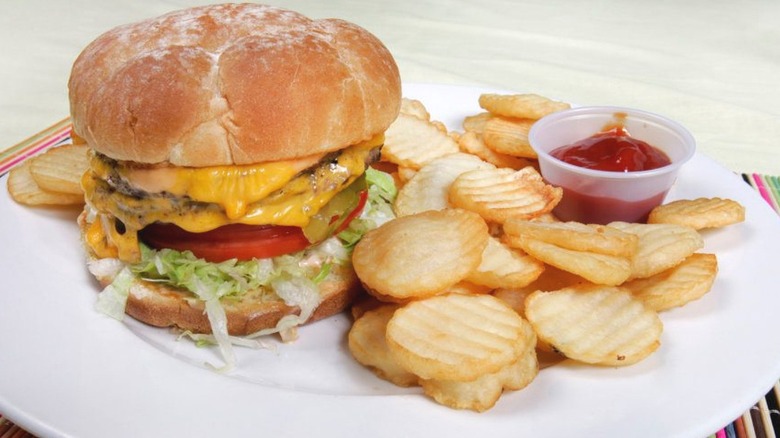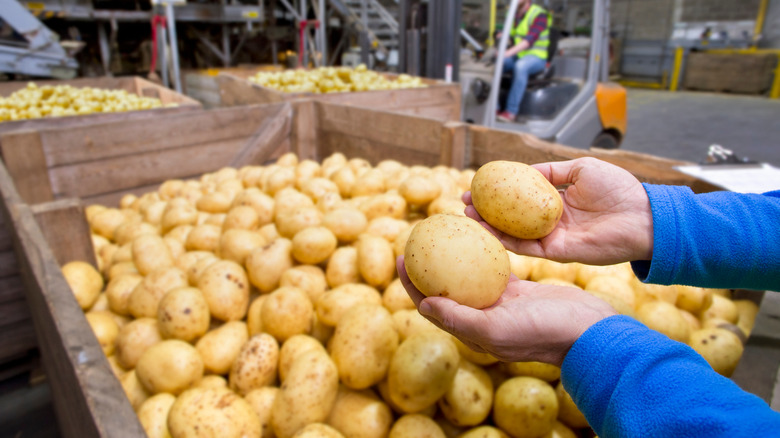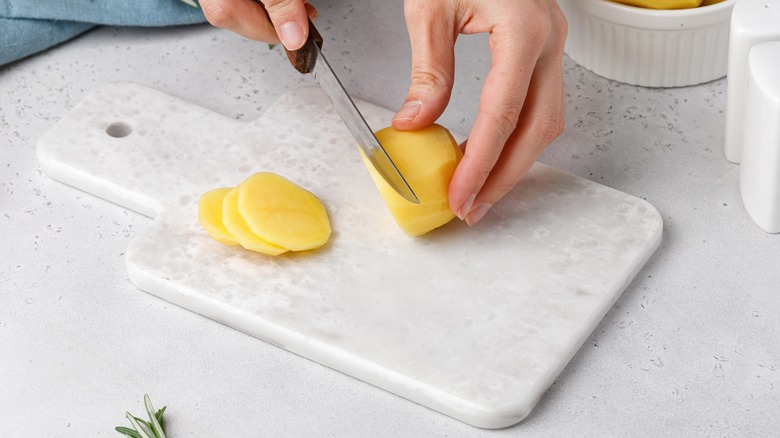What Makes Cottage Fries Unique?
Since potatoes are one of the most versatile vegetables, you may be thinking "there can't possibly be another way to cook it," considering the endless techniques we know of today are already deemed genius enough, such as tater tots, french fries, chips, and even more modern techniques like Hasselback and accordion potatoes. Cottage fries are one of the many ways to prepare a potato, shaped like thick, crinkle-cut, oval-sliced chips for the ultimate dipping experience.
The exact origins of the potato dish are a bit hazy, but it's been popular in New York City since at least the 1970s, per Brooklyn Paper. According to Food Wishes, the name of the dish could stem from the fact that the circular cut of the potatoes resembles shingles on a roof. Due to their cute back story and crisp, yet tender texture, it's no surprise that cottage fries were a staple at places like J.G. Melon, Roll-N-Roaster, and Red Hook Tavern, but recent shortages have caused a slip in their popularity (per Grub Street).
They're hard to produce in high-volume
Cottage fries have had varied availability lately because of issues in the supply chain, according to Grub Street. J.G. Melon and Roll-N-Roaster sparked their popularity, requiring copious amounts to meet the demands of their jam-packed joints, and when a shortage arises, the world wants more. The two restaurants worked with food processing company Lamb Weston closely for wholesale shipments, but due to supply chain issues, they were forced to remove cottage fries from their menu, which sparked concern from their customers — so much so that there's a petition to bring them back on Change.org. However, the company had valid reasons for stopping production.
For starters, the potatoes have to be large in order to get the ideal shape, and some years, potatoes are unfortunately not the cream of the crop. In 2020, potatoes were much smaller. Another aspect to consider is that Weston has 13 production plants across the country, and one of them must shut down completely for the blades to be changed in order to make cottage fries. While it is rumored that Weston has started back production, it's likely to be on a smaller scale, and restaurants can't risk teasing their customers again in case a shortage occurs. If you're lucky, you can sometimes find them pre-cut in an Ore-Ida bag in the freezer section of your local grocery store, but making them at home is even easier.
They're easy to make at home
Making homemade fries can come with the tedious tasks of cutting into sticks, par-frying, then frying again, often leaving the unwelcoming smell of grease in the house. Cottage fries are quite the opposite due to their ease of slicing, no par-frying required, and are just as delicious when baked — with the right seasonings of course (via Scrambled Chefs).
It's best to use russet potatoes when making cottage fries, as they have a higher starch content, which makes them fluffier on the inside, according to The Kitchn. Some staple spices for cottage fries include paprika, garlic powder, dried thyme, cracked black pepper, and you can't forget flaky sea salt. Lastly, olive oil is a must in order for the oven to do the "frying," and potatoes should be sliced no thicker than half an inch. Once they're properly seasoned, roast the potatoes at 450 degrees Fahrenheit for 30 to 45 minutes, flipping them halfway through.
Once baked up nice and crispy, they can be served as a starter or a side to a meaty sandwich. The Kitchn recommends serving them alongside dipping sauces that ramp up the dish even more, like garlic aioli, fry sauce, sweet and tangy BBQ sauce, or keeping it simple with ketchup.


